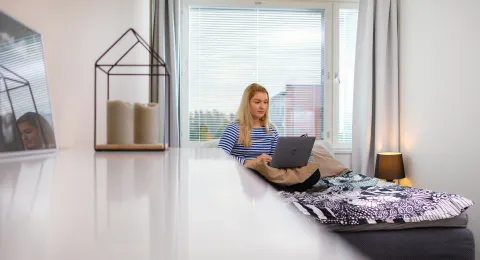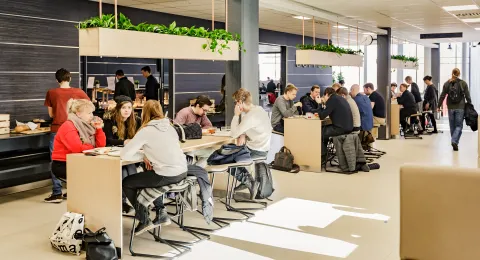The prospect of living by yourself in a whole new country such as Finland can be daunting. Even though some students might luck out and find a part-time job to support their studies, it's essential to plan meticulously and set aside funds before moving to Finland. As a Vietnamese girl who has been living in Finland for one and a half years and faced massive changes in lifestyle, I’m proud that I’ve managed to enjoy a fun, affordable, and comfy student life in Lappeenranta without having to break the bank. Sure, I still have many things to learn, but I want to share some lessons and tips I’ve picked up along the way. Let’s dive into essential expenditure a non-EU international student will encounter while living the student life on the Lappeenranta campus (and probably everywhere else in Finland).
Fixed costs
Fixed costs are called that because they remain relatively unchanged over time, and you always know the exact amount of money to set aside every month.
Fixed costs include:
Rent:
- Rent is around 350-400 EUR on average if you can get housing by LOAS. The price ranges based on the apartment’s condition and location and the age of the building. Many students I know opt to rent an apartment from LOAS, and we can choose a shared apartment or studio room or rent from other housing agencies suggested by LUT. My friends and I preferred the studio option at first, but then, we all realized that sharing an apartment with new friends could be a culturally enriching experience (plus, quicker and cheaper to obtain).
For families, the options at LOAS are very limited and they need to check the private market. The private market comes with higher rent prices. - I've personally spent €235 to €340 per month on rent for various apartments, and I was really surprised to find out that it covers electricity, water, and internet (which was not the case in my home country). That means I don’t have to deal with the hassle of paying multiple individual bills every month! Awesome, isn’t it? As a Vietnamese student, I found the rent here quite affordable since it’s only slightly higher than in my home country. On top of that, my apartment comes with a pre-installed fridge and a kitchen space with an electric stove and oven. In addition, sauna and laundry facilities are always at your disposal, and I’ve started loving going to sauna like a true Finn now. :D
Transportation:
- Lappeenranta is a small city, but commuting from our campus to the city center takes roughly 30 minutes by bus. As a student, you can buy a monthly bus pass for €43 and add it to your personal smartcard, which you can purchase for €5.
- You can save more by keeping an eye out for discounts during the fall season. For me, the bus is the only viable option for commuting here in the winter when it’s snowing. In the summer, you have more options, like riding a scooter, electric bikes, or normal bikes for varying fees, depending on the provider. I was so worried when trying the scooter for the first time because I couldn't keep my balance, but after I got used to it, it became my savior every time I missed the bus.
Student Union fee:
- At the beginning of every academic year, you need to pay a mandatory fee of €74 to the Student Union. If you break it down, it’s only €6 per month. The fee allows you to enjoy various free services, student discounts, and many forms of support for your studies. Check out our Student Union website so you don’t miss out on anything!
Student health care fee:
- You also pay €35.80 per semester for health care services. For one year, it adds up to €71.60. In other words, for only €6 per month, you have access to healthcare services by the Finnish Student Health Service – a.k.a YTHS. If you feel unwell during your stay, don’t hesitate to give them a call.
Example budget - Monthly fixed costs
Rent 340 EUR
Transportation 43 EUR
Student Union Fee 6 EUR
Health Care (YTHS) 6 EUR
395 EUR
Transportation 43 EUR
Student Union Fee 6 EUR
Health Care (YTHS) 6 EUR
395 EUR



Variable costs
Variable costs are necessary expenditure that you can adjust to your preferences and budget.
-
Phone subscription:
Maintaining a connection to the internet is crucial for international students like myself: I need it to stay in touch with friends or access Google Translate to communicate with locals. I received a prepaid DNA SIM card with a value of €5 in my LUT welcome package for free, but you can buy one yourself if you want to. Usually, I pay €20 per month for unlimited data access to contact people online, but if you feel like you don’t need to be online all the time, you can forget the subscription and enjoy free Wi-Fi at the university.
-
Food and groceries:
On weekdays, you can enjoy student meals in an all-you-can-eat style at the LUT buffet or student union restaurant at a discount price of €2.95 per meal. If you don’t feel like cooking for yourself, eating at school is a great option since two healthy meals only add up to €6 a day. Yet, if you’re a great cook or you want to become one, you can save money by cooking at home. I often buy food from Finland’s three biggest grocery store chains: Prisma (S-markets), K-markets, and Lidl for the best prices. If you are a bargain hunter, wait until 6 p.m. every day to shop and enjoy discounts of up to 60% on some groceries – a significant saving tip for tight-budget days. Monthly expenses on food and groceries vary based on lifestyle, but usually, the average is around €150 to €300.
-
Furniture, household appliances, tools:
Once you arrive in Finland, it’s time for the mattress and furniture hunt. In Lappeenranta, I suggest going to Raja Market for cheap and affordable household items. You can check out thrift stores or students’ Facebook groups to discover items that students and locals are giving away for free. Typically, you might spend around €50–100 for essential kitchenware and basic items ensuring a comfortable sleep. Many exchange students give away items at the end of every semester when they move out, so keep an eye on group chats or designated give-away tables at school; you might score cool things for free!
-
Recreation:
Let's not forget about having fun! If you’re a bookworm, the school library is open 24/7 for free. But if you are a party animal, you can enjoy an array of super fun activities by student guilds and ESN at really affordable prices from €3 to €5. Movie night or dining out can cost €15–20, depending on the place you go to.
-
Clothing and self-care:
Another category that depends on preference. I would roughly calculate a generous amount of €100–200 for a warm winter coat and a sturdy pair of winter shoes that will last you several years at least. Don’t forget the thrift stores – they are a must-visit for quality and price (and environmentally friendly too). Thrifting has long traditions in Finland, and you can find many good things in stores like Goodwill or Kontti. For self-care items, you might need a good moisturizer to combat six months of snow here in addition to shampoo, cleansers, soap, etc. These items can cost you up to €10–20 per month.
Example budget - Monthly variable costs
Phone subscription 20 EUR
Food / Groceries 300 EUR
Clothing / Self-care 20 EUR
340 EUR
Food / Groceries 300 EUR
Clothing / Self-care 20 EUR
340 EUR


Other costs for international students
-
Tuition fee:
If you’re an international student, you are obligated to pay a tuition fee unless you are from an EU / EEA country or Swizzerland, so please make sure to find out how much you need to pay annually.
For bachelor’s degrees, € 9 500 per academic year, and for master’s degrees, it’s € 13 500 per academic year.
Don’t forget that you can get an early bird discount - it could save you € 6000 for master's and € 2000 for bachelor's programmes on your first academic year! Check out the full information of the early bird discount here.
-
Health insurance:
As an international student, you also need your health insurance. The most basic one will cost you €180–200 per year.
-
Finnish ID & passport picture (optional):
Sometimes your RP card might not be sufficient to prove your identity, especially online. In such cases, bank identification is needed, requiring a visit to the police station to obtain your Finnish ID card, which costs €60. Additionally, you need to submit a passport picture to the police, costing another €12–20 if taken in a studio. To save on this cost, bring your own passport picture, ensuring it aligns with all requirements from the police station.

The Finnish Immigration Service (Migri) has estimated that living in Finland will cost at least €560 per month.
However, this figure only covers living expenses without important additional fees like tuition fees and insurance.
Saving is key, and one rule of thumb to optimize your finances is to avoid splurging on something that you don’t need. If you want more tips on saving while enjoying a great life here, stay tuned for our upcoming blogs! Also, you can reach out to us LUT ambassadors if you have any further questions!
Hope you enjoyed this blog; feel free to leave a comment!
Linh Nguyen
Master's Student International Marketing
Student Ambassador



